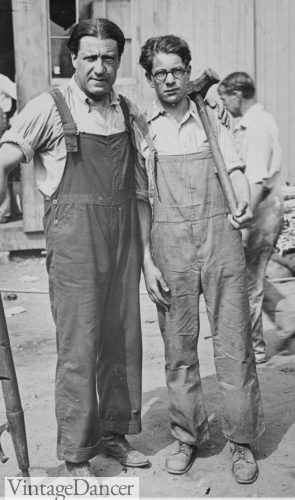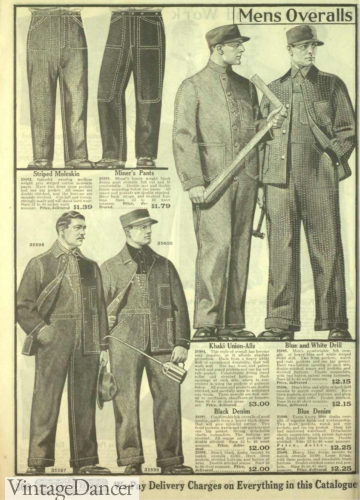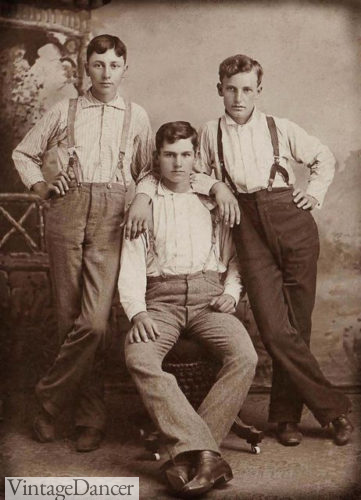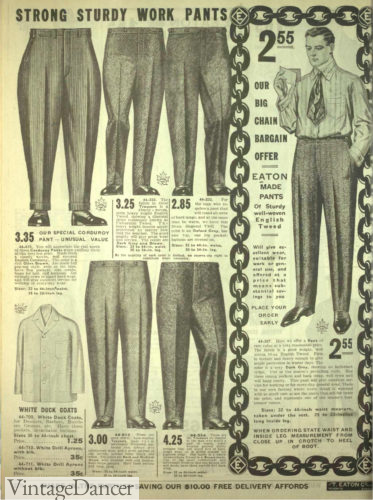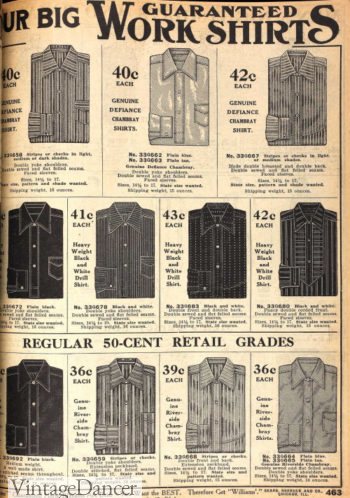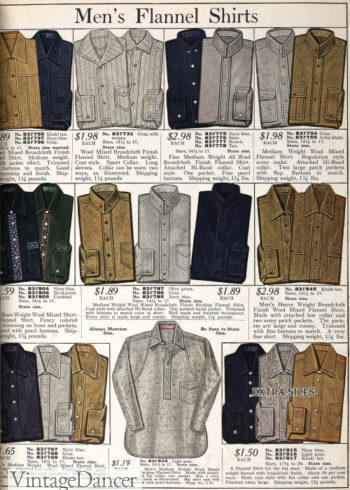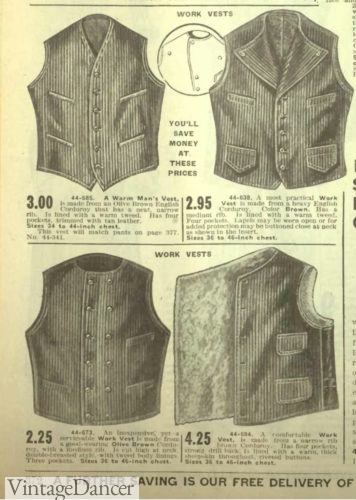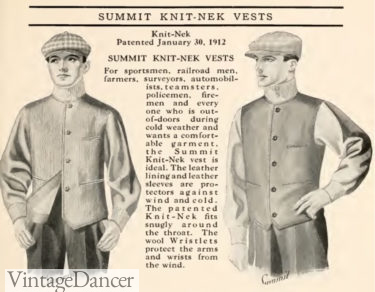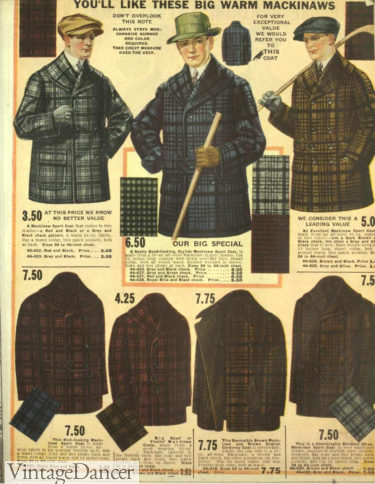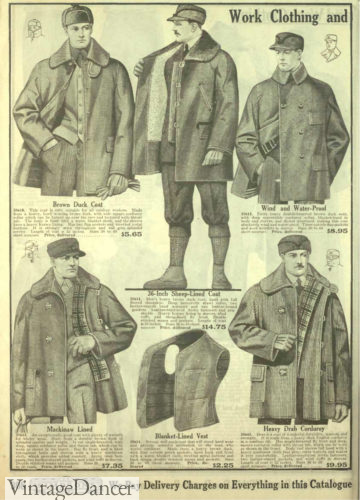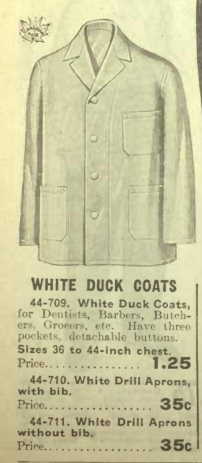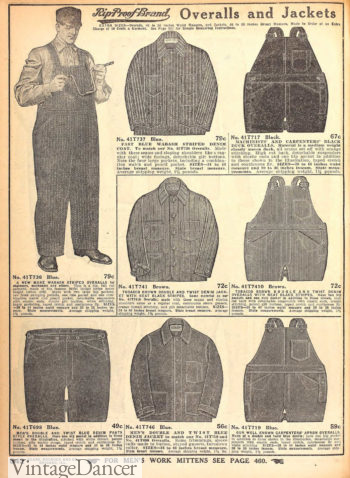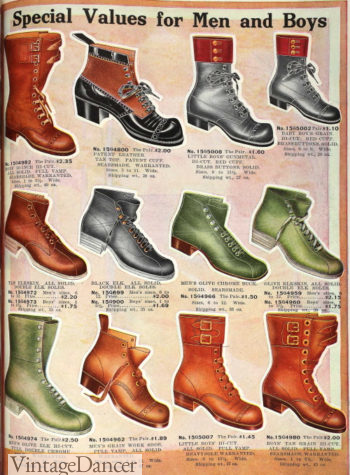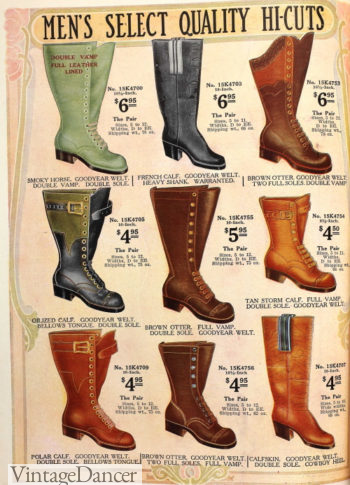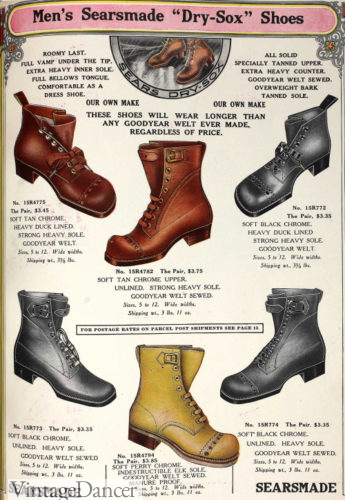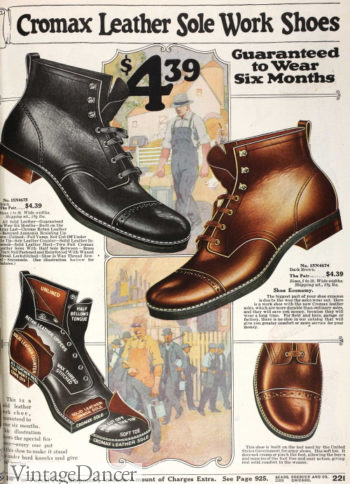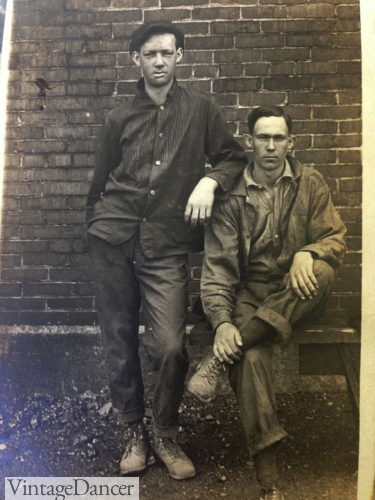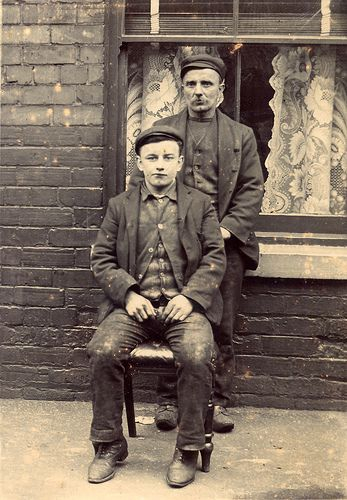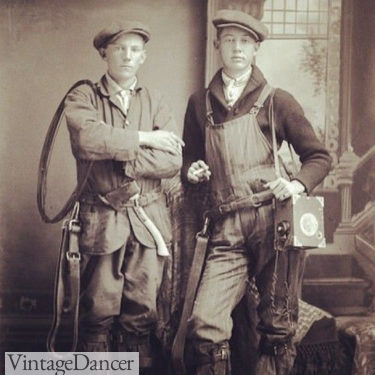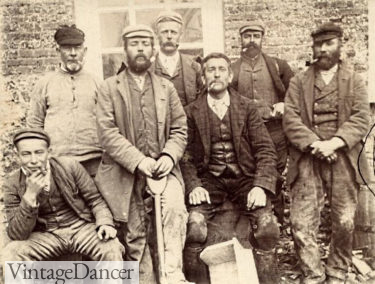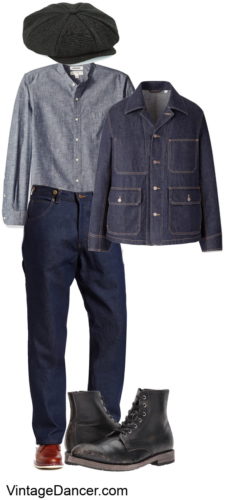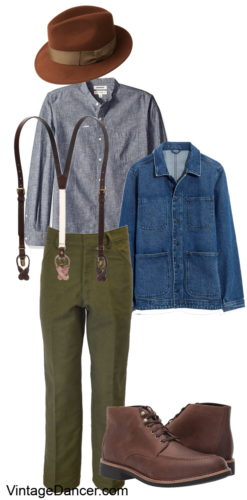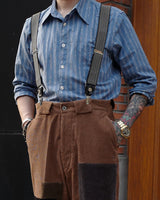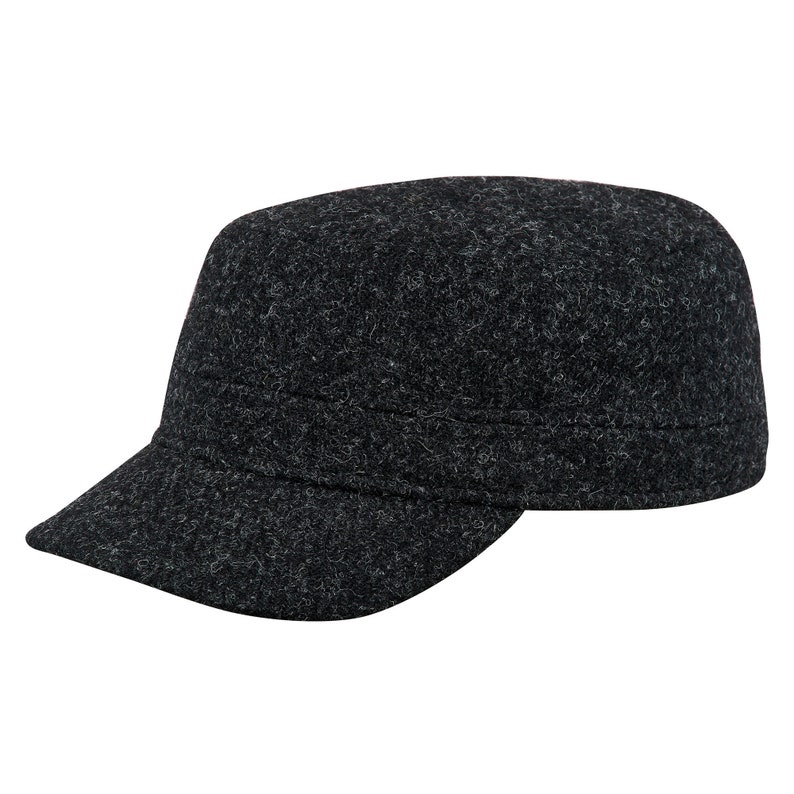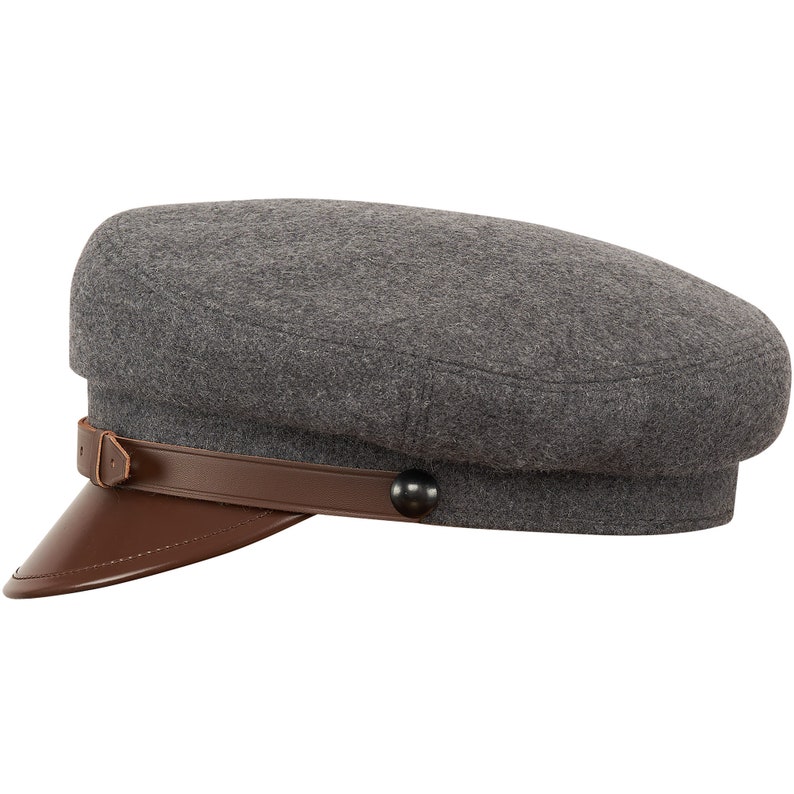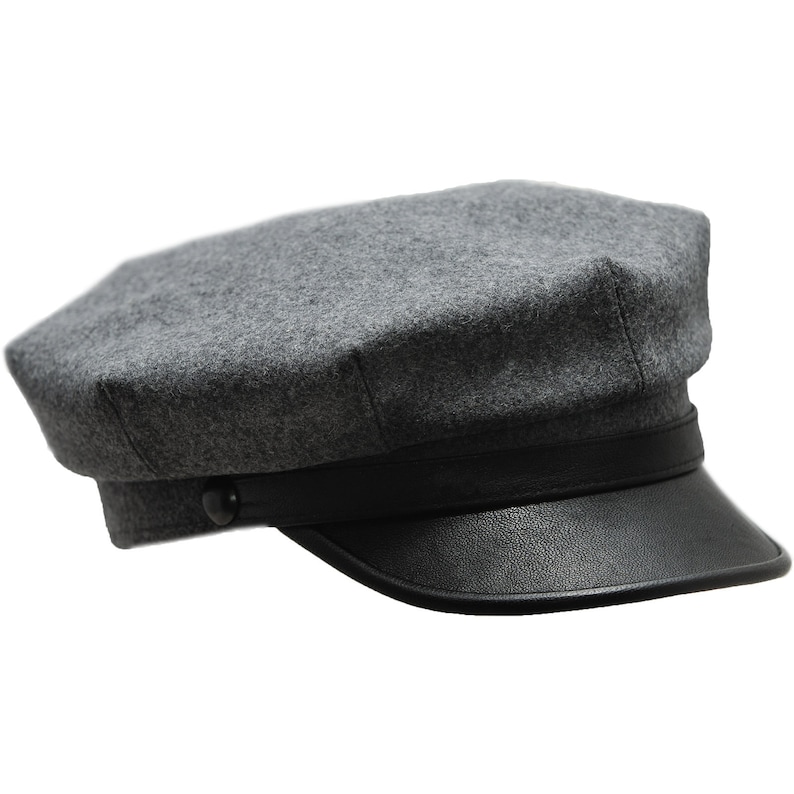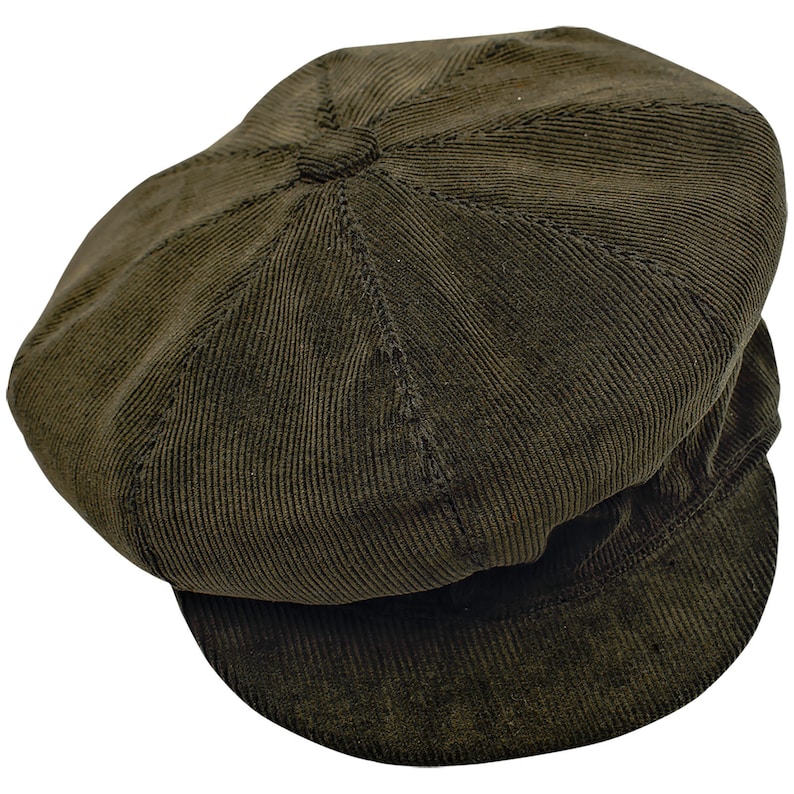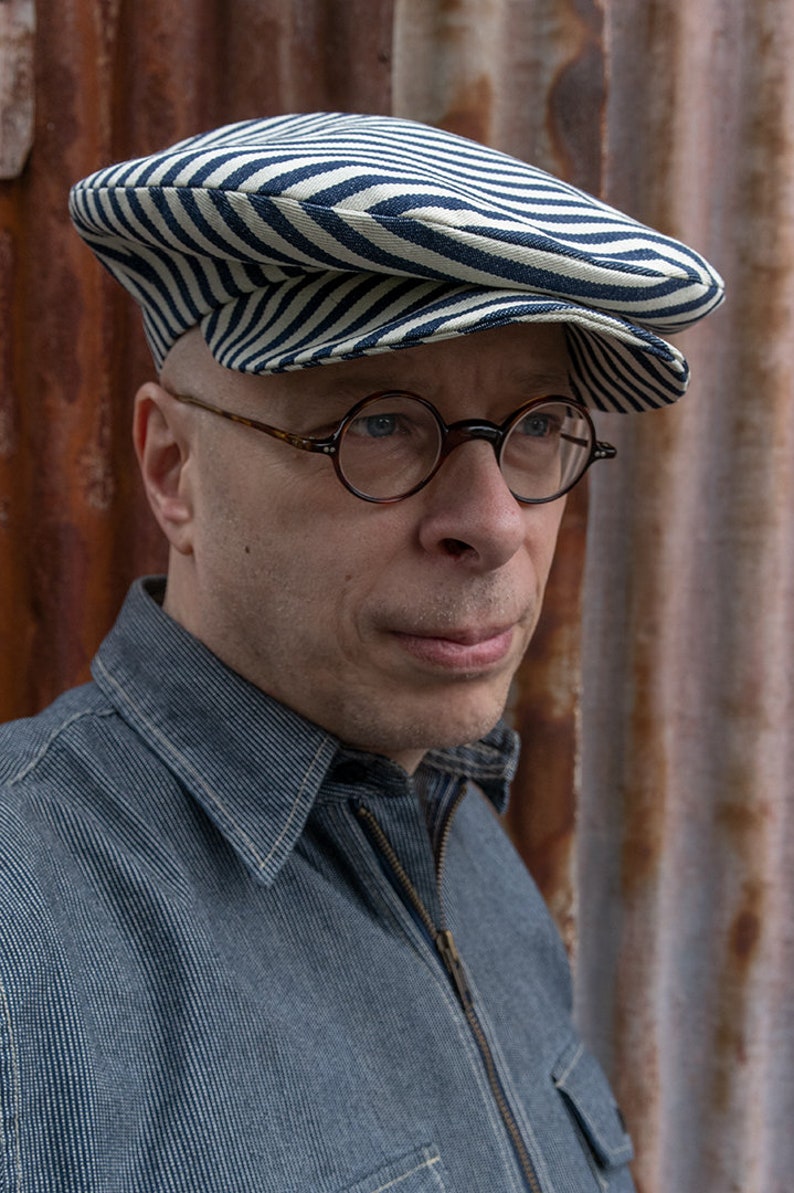Working class Edwardian men still had the misfortune of being able to afford only secondhand clothes and very cheap ready-made clothing. Men worked hard labor jobs for six-day, 52-60 hour weeks in factories, railroads, mines, and farming operations.
New immigrants may have been given uniforms or clothing as part of their new employment (which they had to pay off at outrageous rates). Some men picked through trash in wealthy neighborhoods looking for and repairing discarded clothing.
Since most men’s clothing was made of heavy wool, cotton, and corduroy, the lifetime use of a garment could be ten or more years. When an item was no longer repairable, the fabric could be put to pieces and made into hats, ties, vests, and other smaller items. Nothing was wasted during an expensive and difficult time.
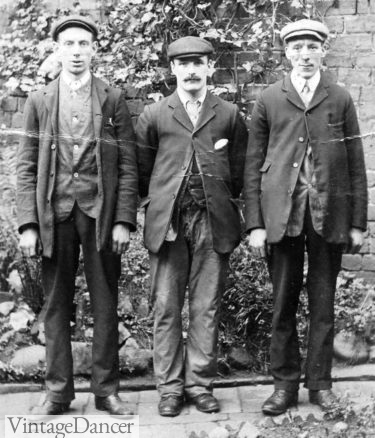
Working class mix and match clothing
Men’s workwear clothing had to be durable, dark, and loose enough to accommodate freedom of movement. There was little emphasis on the style of clothing, as long as it was practical. Being second hand, the Edwardian era styles were based on looks from the late Victorian and early 1900s, with minor modifications and repairs made throughout their lifetime.
The fit of men’s Edwardian working-class clothing was always poor. Pants were held up by suspenders or a belt pulled tight. Jackets rarely matched. Shirts were always soft collared or collarless. Clothing was rarely washed and almost always dirty. Middle-class men or men in management could wear attached white collars and ties and differentiate themselves from their lower class co-workers. Hence the modern terms blue and white collar workers. Read more about 1910s upper class clothing here.
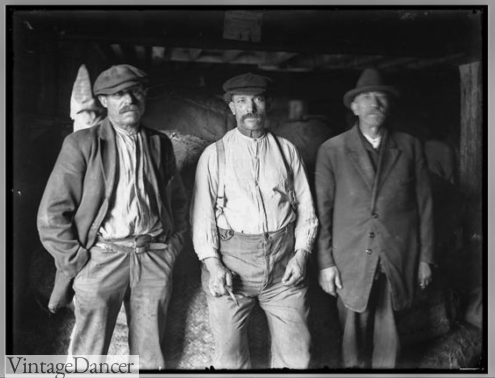
New York dock workers clothing
Service workers (e.g. chauffeurs, bell boys, chefs) were provided new or slightly used uniforms that they sometimes had to pay for. Gentlemen were the only ones who could afford to be impeccably dressed. Often, the only distinction between upper and lower class clothing was the material and fit. Middle-class men in “business” did their best to dress the upper-class part, but usually failed either by buying cheap clothes, wearing outdated styles, or breaking fashion etiquette rules.
Men often wore the same clothes after work, saving their best clothes only for church and special occasions. Most men, except the extremely poor, owned a suit to wear on Sundays, holidays, and special occasions. Since they were second hand or poor quality, the fit was never tailored. Loose, mismatched, and showing evidence of home mending, the suit jacket was the nicest thing they owned, but a far cry from gentlemen’s attire. The suit was often in a style that was 5-10 years old and in dark colors. Once a jacket became unacceptable for Sundays, a man would use it as his everyday jacket. For very special occasions like a wedding or portrait, a poor man would borrow a suit from a wealthier man or purchase a used suit at a second-hand shop but sell it back the following week for less than his initial purchase.
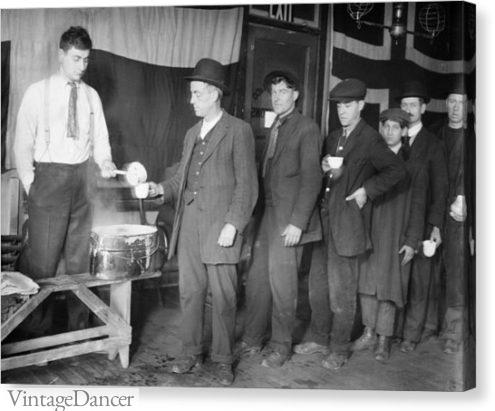
1915 working men at a soup kitchen
Working Class Clothing – Labor Occupations
Unless they were provided with uniforms, working-class Edwardian era men needed clothing that was strong, sturdy, and durable. Two pairs of trousers, 2-3 shirts, a vest, a light jacket, a heavy jacket, one or two caps, suspenders or a belt, and a pair of boots would have been a decent wardrobe for a working-class man.
Men’s workwear pants fit loose around the stomach with a full thigh to a tapered leg. Maximum movement and comfort were important in labor-intensive occupations. Wool tweed, corduroy, cotton drill, and duck cloth made up men’s work pants, with denim as well for overalls and some pants (Levi’s were worn out in the “wild west”). Matching jackets were purchased with pants or overalls. Many had large patch pockets to hold tools.
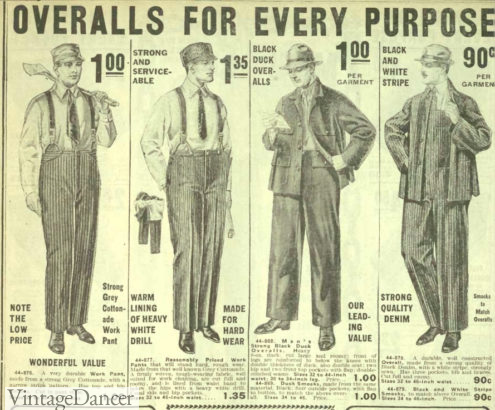
1916 men’s working class outfits – pants, suspenders, soft collar shirts, cap, and jackets. Man on the right wears denim striped overalls with a jacket.
- 1918 cotton overalls
- 1918 workwear overalls, jeans and jackets
- Young men wearing trousers, shirts and suspenders
- 1918 men’s work pants
Work pants had to be held up by button-on suspenders made of striped cotton webbing. Belts were available in the later years and were preferred by men in the summer who went without a vest or jacket. Pants were sold with buttons or suspenders or with belt loops but not both. Some pants were designed for neither, leaving it to the man to get the fit of his trousers snug enough for them to stay up.
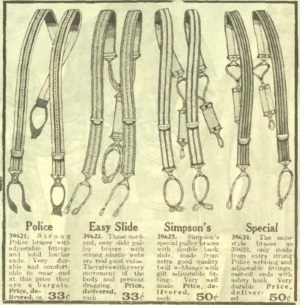
1918 suspenders
Men’s work shirts had a long placket down the front that ended midway, making it a pullover style rather than a full button-down Oxford. Collars had large fold-down points or high band military collars and were usually detachable but soft. Many men only attached shirt collars on Sunday to save them from excessive wear. Wool, flannel, and heavy drill cotton made up men’s work shirts.
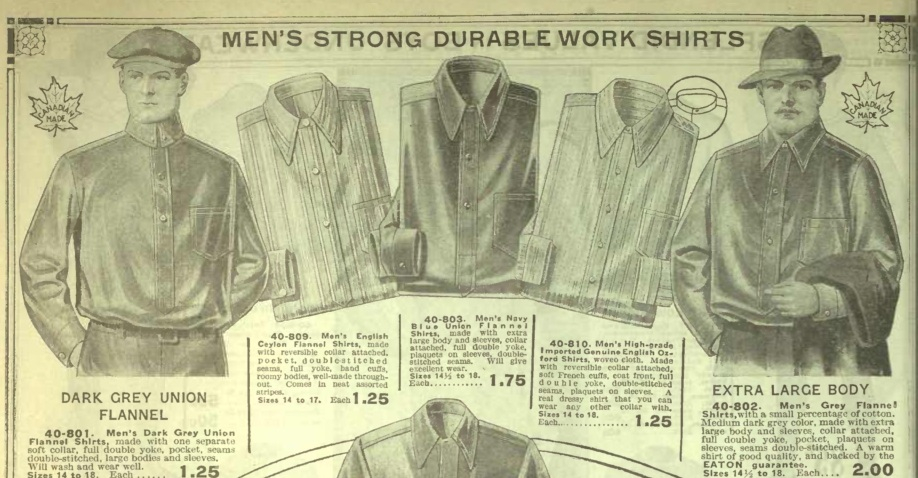
1918 men’s work shirts
Men’s shirt colors were dark grey, navy blue, black, khaki, and brown. Vertical engineer stripes were worn by railroad men, mechanics, and some factory positions. Tartan plaid (Woolen work shirts in red/ black or green/black plaid buffalo) was just becoming an acceptable winter shirt in the later years. A tie was worn by higher-ranking men, while labor men went without or wore a thin scarf loosely tied around the neck.
- 1911 men’s work shirts- chambrey, denim, drill solid and stripes
- 1916 flannel shirts for work or casual attire
One unique item of clothing a working-class man wore was a full vest. Especially in winter, a wool leather-lined duck cloth or corduroy vest buttoned up high to the neck, covering the entire torso. An ample supply of leather jackets and leftover khaki woolen cloth backed vests (called body warmers) after the war started a new trend in men’s vested jackets. Sleeves were added onto the vests, becoming casual yet very warm and affordable jackets for the working class. Some upper-class men adopted this vest jacket for sporting clothes. Read about 1910s upper class casual clothing.
- 1918 corduroy lined working class vests
- 1915 sport vest with leather sleeves and knit neck and cuffs
Other working class jackets were lightweight and plain shop coats. Shopkeepers, pharmacists, butchers, barbers, and other middle-class class professions required white cloth jackets or aprons to be worn. Lower professions wore similar jackets made of denim, wool, or cloth in dark colors. In heavy winter conditions, the sheep lined jacket or mackinaw style coat was the preferable choice.
- 1916 mackinaw jackets
- 1918 sheep lined work jackets
- 1918 White duck cloth shop coat
- 1914 denim chore jackets and overalls
Roll neck knit sweaters and cardigan sweater jackets were favored by some men. Fisherman are the well-known wearers of knit sweaters, although many other men favored their use — especially after the war. When men were accustomed to military provided sweaters, the wearing of sweaters for workwear grew in popularity. Colors, although still dark, gradually moved into some brighter shades such as maroon, blue, grey, and green.
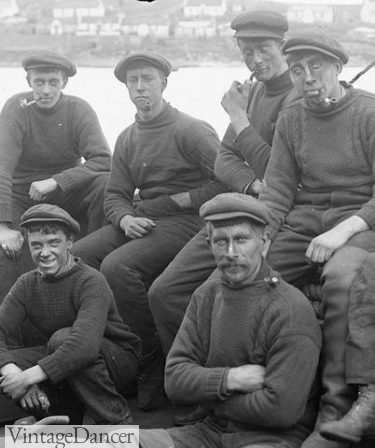
Fishermen wearing Gansey sweaters
The roll neck sweater with stripes across the chest were called Jerseys. They were popular with athletes and young men. The button down cardigan sweater was the ideal knitwear for winter layering. It came in both plain and shawl collars with 2 pockets at the hip.
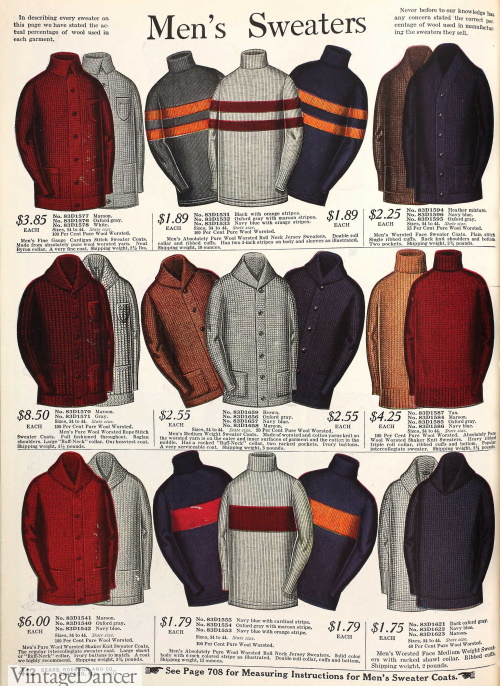
1915 mens sweaters, jerseys and cardigans
Men’s Work Caps and Hats
A working man’s distinction was his hat. While gentlemen and some managers wore derby hats or later on fedoras, working-class men embraced the cap. A soft, floppy, small-brimmed cap came in a few different styles:
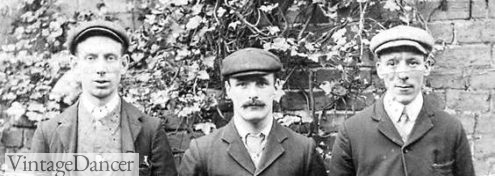
Men’s 8 panel floppy caps
Golf caps, empire caps, or just a “cap” was the most common as well as cheapest style. It was 6-8 triangle panels sewn together and attached to a stiff curved brim. Dark grey, brown, and green tweed were among the limited drab colors. In winter, they were lined with heavy cloth or fur with fold-down flaps to keep ears warm. These hats could easily be made from worn out suits and trousers.
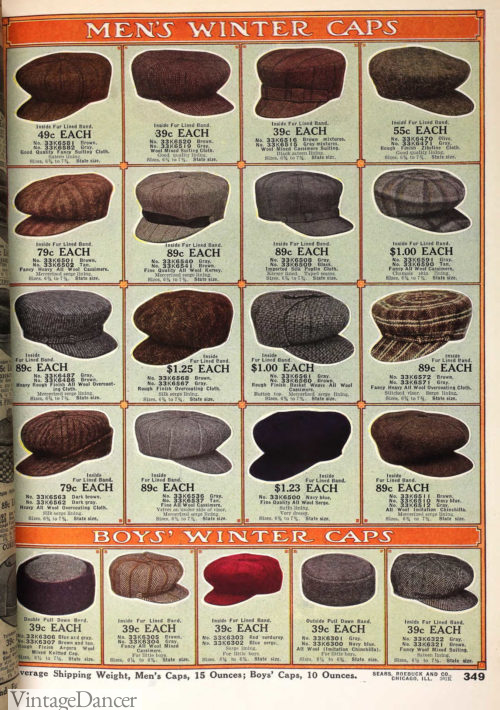
1912 mens caps and hats
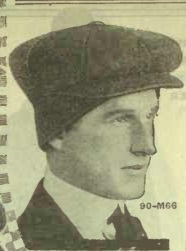
1918 golf cap with ear flaps
A four-panel golf cap was another option that was less floppy than the 8 panel cap. The back was a bit taller and sloped down towards the front brim. It could also have ear flaps in winter.
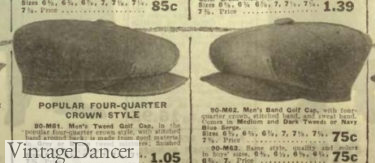
1918 Four panel golf caps
The motor cap, driving cap, or hunting cap took on the shape of a four-panel golf cap, but was usually made of leather or wool. The top was separate from the brim and generally had a rounded crown and ear flaps/neck flap.
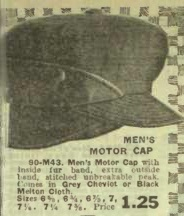
1918 driving cap/motor cap
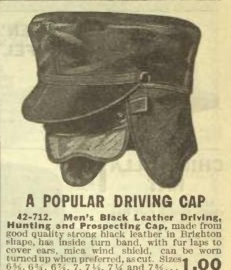
1913 driving cap, hunting or prospecting cap
The Brighton cap, also called a Quebec cap, Klondike cap, or sealette cap, had a stiff round crown with a flat top, a strong angled down small brim, and two flaps that tied in the front with a bow.
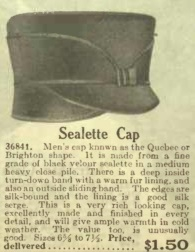
1918 Brighton cap
The Uniform cap was a similar stiff round crown and flat top cap with a flat leather brim. It was worn by men in service such as chauffeurs, bell boys, repairmen, etc.
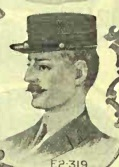
1906 uniform cap
Some seamen sported yachting caps in navy blue or white with a black brim. These were mostly reserved for high ranking captains and officials.
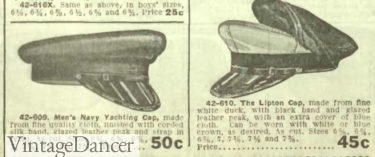
1913 yachting caps
At the end of the decade, a worn out fedora hat could be seen on some working-class heads. By the time a poor man acquired it, the hat had lost most of its shape in the crown, but the wide brim was a welcome change. Read more about men’s 1900s hat styles and 19210s hat styles.
Men’s Work Boots and Shoes
Similar to hats, the selection of men’s workwear shoes was boots, boots, and more boots. For most light to moderate work or in jobs requiring a lot of bending and squatting, the just above ankle lace-up boot was the best choice. Similar to gentlemen’s boots, they had slightly thicker soles, a wider foot (to accommodate thick socks), and were made of strong oil tanned leather (kangaroo leather was considered the strongest). There was also an elastic side panel boot (later called a Chelsea boot) and slip on rain bootie.
For outdoor occupations, a tall leather or rubber boot that laced up the front and had two buckles around the calf allowed men to wear trousers tucked into the boot. Read 1900s-1910s Men’s Shoe and Boot History
- 1911 low and high work boots
- 1912 high lace up boots
- 1914 work boots
- 1918 work boots, cape toe lace ups
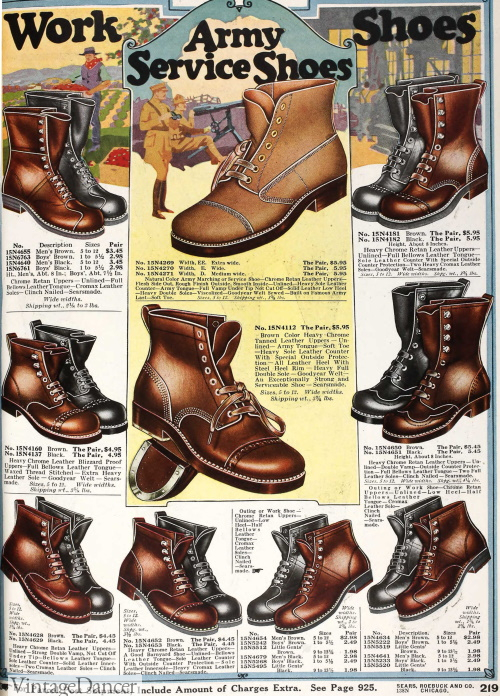
1918 men’s work and army boots
More examples of men’s work clothing (dates from 1900-1919)
- Denim work clothes
- Young working class immigrant men
- Telephone lineman clothing
- 1900 Engineers- slightly better dressed than most laborers
How to dress in Edwardian working-class clothing
Depending on how much effort and expense you want to put into your outfit, there are a handful of ways to put together a working-class outfit or costume.
- Denim on denim workwear
- Everyday workwear or casaul- chambray shirt, denim chore jackets, wool pants, suspenders, fedora hat, boots
- The cheapest option is to pull from your own closet or visit of a thrift store for a pair of worn out work pants (heavy cotton or corduroy is best, denim is ok). Next, add a button down shirt, a vest, and a wool suit coat or sports coat. You can also look for simple overalls instead of pants. Add boots and a cap. Keep the fit very loose (no slim fitting anything). To age your new clothing, soak them in coffee overnight, roll them around in rocks/dirt/grass, or use brown spray paint to dirty them up.
- The next level up requires purchasing vintage inspired or reproduction workwear. Thankfully, vintage men’s workwear has come back in style around the globe (especially Japan and China), so the options are more plentiful. Here are some places to start: Levi’s Jeans co has a line of vintage reproduction denim pants and jackets. Bronson /MAYA is a Chinese repro line new to the US market. Historical Emporium has Victorian to Edwardian era repro shirts, pants, vests and accessories. More brands listed here and here.
- Boots– Most leather workwear boots are still in the classic vintage styles. Justin Original and Red Wing have some of the best choices. Yarmo (Amazon UK) has some coats and shirts. LL Bean, still makes some of their turn of the century clothing.
- Here are some more clothing options I have found online:
Debbie Sessions has been teaching fashion history and helping people dress for vintage themed events since 2009. She has turned a hobby into VintageDancer.com with hundreds of well researched articles and hand picked links to vintage inspired clothing online. She aims to make dressing accurately (or not) an affordable option for all. Oh, and she dances too.
